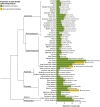Unraveling female reproductive senescence to enhance healthy longevity
- PMID: 36588114
- PMCID: PMC9810745
- DOI: 10.1038/s41422-022-00718-7
Unraveling female reproductive senescence to enhance healthy longevity
Abstract
In a society where women often want successful careers and equal opportunities to men, the early nature of ovarian aging often forces women to make difficult life choices between career and family development. Fertility in women begins to decline after the age of 37 years and it is rare for pregnancies to occur after 45. This reproductive decline in women is inevitable and culminates in menopause, which is a major driver of age-related diseases. In a world where biomedical advances are leading to modifiable biological outcomes, it is time to focus on mitigating female reproductive senescence to maintain fertility and preserve age-related hormonal functions, with the goal of providing increased life choices and enhancing healthspan. To date, reproductive longevity research remains an understudied field. More needs to be done to unravel the biology of the ovarian follicles, which are the functional units of reproductive lifespan and are comprised of cell types including the oocyte (female gamete) and a group of specialized supporting somatic cells. Biological attempts to maintain the quality and quantity of follicles in animal models through manipulating pathways involved in aging can potentially prolong female reproductive lifespan and healthspan. Here, we summarize the molecular events driving ovarian aging and menopause and the interventional strategies to offset these events. Developing solutions to female reproductive senescence will open doors to discover ways to enhance true healthy longevity for both men and women.
© 2022. The Author(s) under exclusive licence to Center for Excellence in Molecular Cell Science, CAS.
Conflict of interest statement
The authors declare no competing interests.
Figures



Similar articles
-
Reproductive potential in the older woman.Fertil Steril. 1986 Dec;46(6):989-1001. doi: 10.1016/s0015-0282(16)49869-9. Fertil Steril. 1986. PMID: 3536609 Review.
-
Reproductive Longevity and Aging: Geroscience Approaches to Maintain Long-Term Ovarian Fitness.J Gerontol A Biol Sci Med Sci. 2021 Aug 13;76(9):1551-1560. doi: 10.1093/gerona/glaa204. J Gerontol A Biol Sci Med Sci. 2021. PMID: 32808646 Free PMC article. Review.
-
Ovarian aging in humans: potential strategies for extending reproductive lifespan.Geroscience. 2023 Aug;45(4):2121-2133. doi: 10.1007/s11357-023-00768-8. Epub 2023 Mar 13. Geroscience. 2023. PMID: 36913129 Free PMC article. Review.
-
Ovarian reserve assessment in users of oral contraception seeking fertility advice on their reproductive lifespan.Hum Reprod. 2015 Oct;30(10):2364-75. doi: 10.1093/humrep/dev197. Epub 2015 Aug 25. Hum Reprod. 2015. PMID: 26311148
-
Late-life reproduction in an insect: Terminal investment, reproductive restraint or senescence.J Anim Ecol. 2021 Jan;90(1):282-297. doi: 10.1111/1365-2656.13367. Epub 2020 Oct 28. J Anim Ecol. 2021. PMID: 33051872
Cited by
-
Differential age-related transcriptomic analysis of ovarian granulosa cells in Kazakh horses.Front Endocrinol (Lausanne). 2024 Jan 30;15:1346260. doi: 10.3389/fendo.2024.1346260. eCollection 2024. Front Endocrinol (Lausanne). 2024. PMID: 38352714 Free PMC article.
-
Polyamines in Ovarian Aging and Disease.Int J Mol Sci. 2023 Oct 18;24(20):15330. doi: 10.3390/ijms242015330. Int J Mol Sci. 2023. PMID: 37895010 Free PMC article. Review.
-
High-fat diet-induced L-saccharopine accumulation inhibits estradiol synthesis and damages oocyte quality by disturbing mitochondrial homeostasis.Gut Microbes. 2024 Jan-Dec;16(1):2412381. doi: 10.1080/19490976.2024.2412381. Epub 2024 Oct 16. Gut Microbes. 2024. PMID: 39410876 Free PMC article.
-
Identification and validation of senescence-related genes in polycystic ovary syndrome.J Ovarian Res. 2024 Jan 6;17(1):7. doi: 10.1186/s13048-023-01338-4. J Ovarian Res. 2024. PMID: 38184636 Free PMC article.
-
Single-Cell Atlas of Human Ovaries Reveals The Role Of The Pyroptotic Macrophage in Ovarian Aging.Adv Sci (Weinh). 2024 Jan;11(4):e2305175. doi: 10.1002/advs.202305175. Epub 2023 Nov 30. Adv Sci (Weinh). 2024. PMID: 38036420 Free PMC article.
References
-
- United Nations Department of Economic and Social Affairs. World Mortality 2019 Data Booklet (United Nations Department of Economic and Social Affairs, 2019).
-
- Ginter E, Simko V. Women live longer than men. Bratisl. Lek. Listy. 2013;114:45–49. - PubMed
Publication types
MeSH terms
LinkOut - more resources
Full Text Sources
Medical

